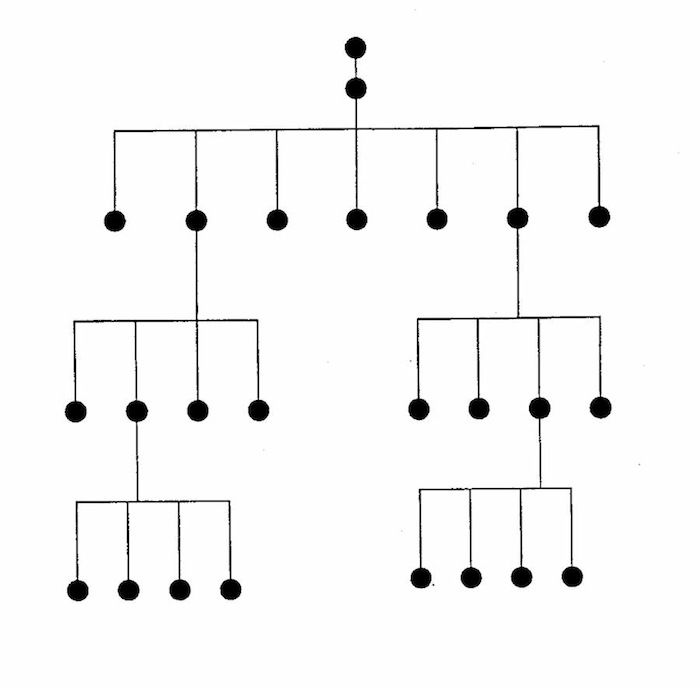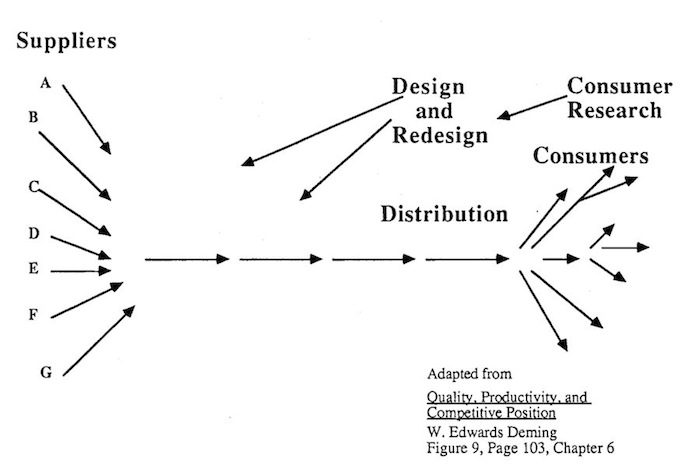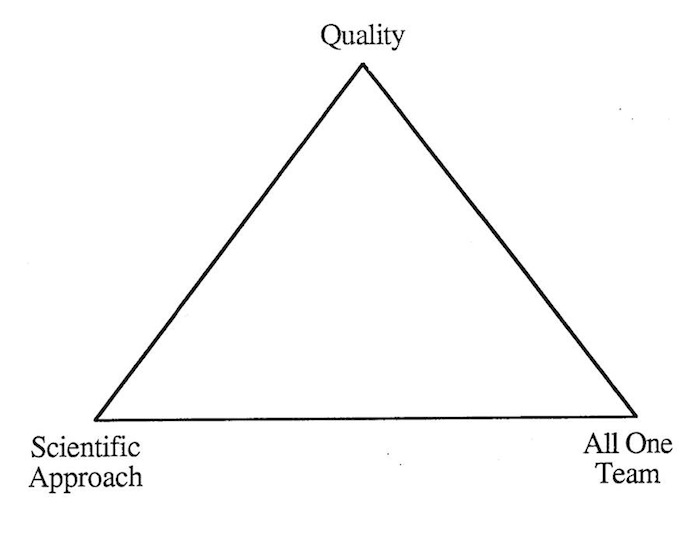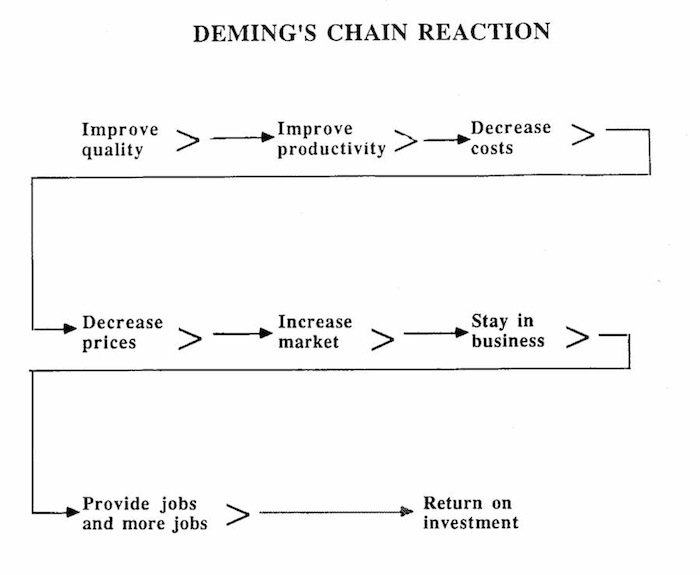Total Quality Leadership vs. Management by Control
Brian L. Joiner and Peter R. Scholtes
February 1988
Practical Significance
Many American companies are in trouble--losing old customers and failing to find new ones. Many managers do not comprehend what is happening or why it is taking place. This report seeks to explain some of the dynamics of the current situation in this country. The most common form of management in America is management by control. There is a new and better way to manage, total quality leadership. This report describes these two philosophies of management. It is argued that all managers have a job to help their organizations learn and implement total quality leadership. Details are given about what individual managers can do to help implement needed changes.
Key Words: Management, total quality leadership, management by control, loss of customers, international competition, fear, Deming, Deming?s chain reaction, Scientific approach, all one team, quality.
Introduction
America faces a deeply troubling future.
We are in the midst of a transition to a world economy increasingly dominated by the Pacific Basin countries, a turnaround in the economy from the red-hot inflation years of the late 1970, and a revolution in technology that is altering battle plans on nearly every front every day. America is struggling in a world where companies, governments and organizations have to rim fast and smart to stay alive.
Many American companies are in trouble - losing old customers and failing to find new ones. Yet many managers can not comprehend what is happening or why it is taking place.
Manufacturers have been hurt badly by foreign competition that is producing higher quality goods at lower prices. Many firms - both manufacturing and service companies such as airlines and banks - are facing chaotic market conditions as a result of deregulation. State and local governments, already subject to cutbacks of federal funds, struggle to make up revenues through higher taxes. State is pitted against state in fierce competition to attract new jobs.
We believe that one major cause of these problems is the failure of American managers to realize that there is a "new" way to manage their organizations - a way that yields much higher quality, higher productivity, more jobs and better return on investment.
We call this system of management Total Quality Leadership.
Total Quality Leadership is a way of managing any organization - whether it be a Fortune 500 corporation, a university or a family restaurant. Total Quality Leadership can create sustained growth from the chaos of today?s marketplace. With Total Quality Leadership practiced throughout the economy, America can regain its competitive position in the world market.
All managers have a job to do to help their companies learn and implement the new approach. In this article, we will describe the new approach to management which needs to be practiced by the entire organization. And then we will give some details about what individual managers can do to help implement these changes. First we will examine what we call "Management by Control," the most common form of management practiced in American companies today.
Management by Control

Figure 1. Management by Control
The classic organization chart was invented 150 years ago. It depicts the separation and decentralization of functions. Management by Control uses this chart for a second purpose: to describe the downward path of a system of control and accountability. Each person, represented by a dot on the chart, is governed and evaluated through a set of numerical objectives, performance standards or work quotas. This network of controls is typically constructed so that the sum of the accomplished objectives at one level will fulfill the objectives of the person immediately above. The apparent logic of this system of controls tends to obscure its harmful side effects.
Management by Control
American managers, for the most part, are a tough lot who have accomplished much. They have helped build the strongest economy the world has known. And yet they are losing control. They have not used the full potential of their organizations. They have failed in many respects to satisfy their customers. And so they are losing them.
Most American managers manage, at least in part, by Management by Control. In this style of management, the emphasis is on the organizational chart and the key control points within that structure (Figure 1). Each manager, beginning at the top, is given certain goals for the next year. They, in turn, act goals and impose controls on each of their subordinates. A CEO, for example, may be given simply a profit objective. He or she wil then typically give each division head a profit objective. A division head then has to set goals or quotas for each department head. In a manufacturing organization, for example, the sales department may be told to increase sales by 10%, production to increase productivity by 5%, engineering to get products into production 10% faster, purchasing to reduce costs by 5%, quality to decrease warranty costs by 20%, and so on. At the lower levels, these goals become quotas or work standards.
Management by Control is simple, logical and consistent. It seems to have been quite successful. It is practiced by nearly every major American corporation. It is widely taught in business schools. And it is attributed by many for getting us to where we are today.
But there is an underside to Management by Control Consider these examples:
- An electronics firm typically ships 30% of its production the last day of the month. Why? In order to meet the monthly shipment quota. How? By expediting parts from around the country, by moving partially completed instruments ahead of their place in line, and, occasionally, by letting quality standards slip.
- Another firm sometimes ships incomplete instruments. A service representative then flies around the country installing the missing parts. The shipment quota for the month is met again. Profits, at least on paper, hold firm.
- A chemical plant reports it cannot efficiently run at the mandated inventory levels, so it keeps inventories higher until June 30 and December 31 when inventories are measured. For those days, it depletes the inventories to an acceptable level, perhaps losing two days production as a consequence.
- Many managers annually negotiate safe goals and manage to exceed them, just barely. Some managers include on their list of negotiable goals items which were already secretly accomplished prior to the negotiation.
- Production which exceeds the standards is stored so it can be pulled out and used another day.
- A meter reader stops at a tavern at 2:00 rather than exceed his work standard.
- Problems are hidden from management, in hopes they will blow over and not be noticed.
These are just a few of examples of problems that occur with Management by Control. It has many shortcomings. Most occur because the larger purpose and greater good of the work being done gets displaced by the controls themselves. The workers, supervisors and the managers get caught up in organizational pretense where looking good overshadows doing well.
Here are but a few of the many negative aspects of Management by Control:
- It is a system of controls. The rewarded accomplishments are therefore necessarily measurable and short term. The near horizon gets attention and countable accomplishments get priority even though an organization?s survival may depend on the unmeasurable activities undertaken to accomplish long term results.
- Systems of controls without a long-term, larger purpose will always set up conflict in an organization. The controls which direct one unit?s short-term gain will contradict the controls which direct the short-term gains of another unit. Sales will make promises which production can?t keep. Engineers will rush products into production before they are ready. Purchasing will buy materials which the warehouse can?t store and the people on the line can?t use. Planners and policy-makers plan programs which service personnel aren?t equipped to provide. Each group struggles to conform to its controls independently of other groups and sometimes at their expense.
- When measurable controls are unattainable or impractical, individuals and groups tend to fabricate conformance. They "play the game" because not to do so would risk looking bad. The twice-per-year depletion of inventories is a movie-set approach to conformance. Behind the appearance, there is no substance. But it looks like controls are in effect.
- This charade of conformance fosters guarded communications, minor -- and even major --dishonesty. The greater the stress on reaching unattainable goals, especially when someone?s career is on the line, the more likely it is that the figures will be juggled.
- The inevitable contradictions between the controls of different departments leads to finger pointing, blame games and an endless series of excuses like "if it weren't for them..."
- Related to the blame-it-on-them mentality is a cover-your-rear mentality: play it safe, don't trust anyone and make sure that when the system breaks down, someone else is at the switch. In times of stress, circle the wagons. Don't help others, especially if they?re under fire.
- Behind the worst shortcomings of Management by Control is fear. Fear is the prime motivator in a Management by Control system. And the more rigid and unrealistic the controls are, the deeper is the fear.
- Management by Control encourages an organization to look inward at its own structures rather than outward at the world in which the customer operates. Rather than delight in providing a product or service that works and satisfies the customer, the sense of accomplishment comes from meeting the controls. It becomes a self reinforcing cycle. A manager or supervisor has a goal imposed on him or her. The manager works to meet that measure, however much distortion might occur at some other time or place in the organization. Meeting the short term measurable goal is an indicator of the success of the individual and the success of the system of controls. Thus, there is fostered a Titanic-like complaisance about the invulnerability of the operation. When there finally is some awareness that the indicators of control may be focused on the wrong measurements, it?s too late. The ship is going down and "Nearer My God to Thee" is heard from the afterdeck.
It is interesting to note that Management by Control is widely used in Soviet Union. Typical is this story: Several years ago there was a surplus of large nails and a shortage of small ones.
Why? Managers were held accountable for the tons of nails produced. Later the control was changed to the number of nails produced. This led to a shortage of large nails, since smaller nails gave higher counts.
Managers often say, "I agree, there are serious problems with Management by Control, but what is a better alternative?"
The alternative, we believe, is Total Quality Leadership.
Simply put, Total Quality Leadership is an approach to management which focuses on giving top value to customers by building excellence into every aspect of the organization. This is done by creating an environment which allows and encourages everyone to contribute Lo the organization and by developing the skills which enable them to scientifically study and constantly improve every process by which work is accomplished.
In all organizations there are processes by which things get done. There are processes of production, of sales and of distribution. There are also processes to find out about customer needs and problems. There are processes that couple market information with information on new technologies. These in turn generate ideas for new products and services. Other processes create and test these new products and services and move them into routine production. Still other processes study costs and value added throughout the organization. There are literally thousands and thousands of processes, the overall health of which determines the future of the enterprise.
In Total Quality Leadership the emphasis is on studying these processes (Figure 2) and on executing them better and better to provide customers with products and services of ever increasing value at ever lower costs.
The focus in Total Quality Leadership is on Quality -- the quality of every product and service and the quality of every process ? this emphasis on quality is shown at the apex of the triangle in Figure 3.
To achieve this higher quality, every process, beginning with the most important, is studied using the Scientific Approach. Processes are described with flow charts, problems are identified, the root causes of problems are determined through careful research and new fool-proofed systems are developed. Every process is brought under statistical control and variations are further reduced, well beyond specifications.
The use of the Scientific Approach, as shown at the bottom left of the triangle in Figure 3, becomes pervasive.
In many cases, the most difficult aspect of Total Quality Leadership, to create an environment of All One Team. To be truly excellent in every activity, requires that everyone throughout the organization work together to improve processes and to execute them with energy and efficiency. It requires a fundamentally different view of the relationship between employees and the organization. In order for all employees to be committed to the organization, the organization must be committed to its employees. This environment of total teamwork cannot be developed under Management by Control Total Quality Leadership is not widely practiced in the United States, but it is not new, nor is it foreign. Its roots go back to the early 1900s and it is principal prophet is a Sioux City, Iowa, native named W. Edwards Deming. A statistician by training, Deming formed many of his theories during World War U when he taught industries bow to use statistical controls to improve the quality of production.
But when the war ended, American industry turned its attention to meeting the huge demand for consumer goods, without the pressure for efficiency or quality that guided it through the war years. And for almost 20 years there was no foreign competition.
Total Quality Leadership
The Deming Way

Figure 2. Total Quality Leadership.
Rather than focus on a hierarchy of individual accountability, the Deming Way focuses on the processes by which the work gets done. It has a different internal logic: each internal process must work well and interact well with the processes which precede and follow it. Together all the processes must result in products or services which meet or exceed the customer's expectations. Continuous communication with customers provides the feedback needed to improve the organization's products and services, and the processes by which the work gets done. Imposed goals, quotas, and exhortations are recognized as generally harmful. As Dr. Deming says, "A goal that lies beyond the capability of the system cannot be achieved except at the destruction of the other systems in the company." Employees are viewed not as points of control, but as willing collaborators in an ongoing effort to improve every aspect of the organization's work.

Figure 3. The Joiner Triangle.
The three fundamental elements of Total Quality Leadership begin with a focus on Quality - that is, a focus on customers. Use the Scientific Approach to study and improve all of the organization's processes. And treat everyone as "All One Team": break down barriers and drive out fear so that everyone can work for the company.
Across the Pacific, however - where "Made in Japan" meant junk - there were people willing to listen. Deming cold them to find out what their customers wanted, then to study and to improve their product design and production techniques until the quality of the product was unsurpassed. He taught them the product was "still in the development process when it was in the customer's hands."
His influence began with a dinner meeting in 1950 organized by the Japanese Union of Scientists and Engineers with 45 leading industrialists at industry club in Tokyo.
He has since recalled that meeting. We will quote his recollections extensively, since they are so central to his thesis:
They thought they could not (compete) because they had such a terrible reputation for quality.
I told them, "You can produce quality. You have a method for doing it. You've learned what quality is. You must carry out consumer research, look toward the future and produce goods that will have a market years from now and still stay in business..."
Incoming materials were terrible, off gauge and off-color, nothing right - I urged them to work with the vendors and to work on instrumentation. A lot of what I urged came naturally to the Japanese, though they were not doing it. I said, "You don't need to receive the junk that comes in. You can never produce quality with that stuff. But with process controls that your engineers are learning about -- consumer research, redesign of products -- you can. Don't just make it and try to sell it. But redesign it and then again bring the process under control - with an ever-increasing quality.
"I told them they would capture markets the world over within five years. They beat that prediction. Within four years, buyers all over the world were screaming for Japanese products."
The rest, as they say, is history.
Here are some of the key components of Total Quality Leadership:
- It recognizes - as Dr. Joseph Juran has argued since the early 1950s -- that at least 85 percent of the failures in any organization are the fault of systems controlled by management. Fewer than 15 percent of the problems are actually worker related. In Total Quality Leadership, the focus is thus on constantly and rigorously improving every system.
- It asserts that work is not haphazard. It can be and must be studied, analyzed and scientifically dissected.
- - Processes must be standardized and the standardized procedures must be followed. Variation must be reduced in output and in the way things are done, yet the opportunity must be provided for everyone to contribute to improving the processes and to eliminating problems.
- - It has a customer focus, an obsession with quality.
- - It recognizes that there are both external customers and internal customers -- other employees who depend on your work to be able to perform their jobs properly.
- The development and communication of a clear vision of the organization?s future. It is a vision which says: here is what we are, here is what we do, here is where we?re heading and here is what is important and unique about us.
- The formation and development of true management teams. They are essential for leading the company in its normal business functions and for leading the implementation of Deming's approaches so that Total Quality Leadership itself becomes a "normal business function." Teams are essential for maintaining "constancy of purpose," for "breaking down barriers" between departments, and for "driving out fear" among the managers themselves.
- Targeted implementation efforts and an overall strategy. A common mistake is for companies to try to involve too many people too soon in the improvement efforts. It is easy to plant a big garden, but very hard to tend it, harvest it, and make good use of the crops. Don?t begin more improvement efforts than you can realistically support and maintain.
- - Management-selected projects and project teams using the scientific approach to improve processes. Usually the teams consist of a mixture of professional staff, managers, supervisors, and hourly employees who use scientific methods to study and improve processes.
- - Developing or recruiting key resources, including a senior statistician, a senior organization development specialist, and intermediate level resources who are trained in both statistics and organizational development to coach project teams. They play a special role in assisting the transformation by providing help with the scientific investigation of processes and with facilitating the dramatic changes in the organization, its management and its culture.
- Leadership, participation and oversight by managers, beginning at the top. This is an absolute essential. The most frequent cause of failure of any quality improvement effort Is the non-involvement or indifference of top and middle management. Passive support is not enough.
- It demands improved relations with suppliers, a true working partnership, which in most cases will require a single supplier for each item.
-The emphasis is on process improvement rather than individual accountability.
- Communication systems are adapted to the needs of the work, not the needs of the hierarchy.
- There is constancy of purpose throughout the organization, persistence in accord with a clear and widely understood vision. It is an environment which nurtures total commitment from all employees. Rewards go beyond simple benefits and salary to the belief we are family and "we do good work."
Total Quality Leadership is a management philosophy that starts with the customer, not with the bottom line profit and loss statement.
It is very data oriented and calls for monitoring thousands of variables inside and outside the organization. These numerical measures are used to guide the search for better performance, and are recognized as means rather than ends, as guides to deeper truths, rather than items to be controlled.
In Total Quality Leadership there is freedom, yet there is control. There is the freedom to discover new markets, to develop new systems, to gain greater mastery over the processes. And there is the control of a data based approach to improvement.
Many managers have great trouble understanding why they should focus on improving the systems that serve the customer rather than simply on profits. The Deming Chain Reaction in Figure 4 may help.
When quality is increased by improving processes (not by expanded inspection), the better quality will lead to improved productivity. This leads to lower costs, which lead to lower prices. Better quality and lower prices mean the company can expand its market, and can stay in business creating jobs and a greater return on investment.
Management by Control, on the other hand, tends to focus only on the end result -- the return on investment; it is like wagging the tail to keep a dog healthy.
It is a tough concept to comprehend and it takes a leap of faith to make the fundamental shift from Management by Control to Total Quality Leadership. There is no easy way to make the change. It seems best to us to use a gradual process of letting go from the old style while embracing the new.
Mary Ann Gould, president of Janbridge Corporation and the leader of the Philadelphia Area Council for Excellence, thinks of it as a "revolution in thought," and an "evolution in implementation."
Working partly in collaboration with Gould, and receiving considerable advice and counsel from Dr. Deming, we have developed a general model for implementation. Our model is not static as we continue to learn by working with a variety of organizations seeking to make the transformation.
Key elements of this model include:
- The education and re-education of managers. They must become leaders instead of bosses, coaches instead of enforcers. They must focus on solving problems and constant improvement instead of blaming and controlling. The quality-focused approach to leadership requires continuous feedback from the customer, and constant communications and feedback within and between units of the organization.

Figure 4. The Deming Chain Reaction.
When you improve quality by improving processes not by increased inspection, the result is improved productivity. Better productivity means decreased costs and the potential for lower prices. Better quality and lower prices mean increased market and the ability to stay in business and provide jobs and more jobs. All this put together gives shareholders a solid return on their investment. (The Last element, "Return on Investment" has been added by the authors).
Total Quality Leadership must involve everyone.
Developing champions who will help the transformation succeed even during rough periods.
How to Get Started
For managers who want to contribute to the transformation to Total Quality Leadership, there is much to Learn.
If you haven't already done so, we suggest you read the books of Deming, Juran, Ishikawa and the papers by Tribus and Fuller listed below. Attend the four-day seminars by Deming and Juran. Visit Japanese managed companies here and abroad. Expand your knowledge of statistics and organization development.
Remember, the best way to get others to change is for you yourself to change. Begin with your own work. What can you do to improve the quality of your work and the satisfaction of your "customers" - listen to your "customers" and to those with whom you work. In whatever decisions you make in your job, begin replacing educated guesswork with reliable data. Strive to eliminate blaming and replace it with problem-solving.
Begin to practice the new approach with others in your department. Work with people to break down barriers and drive out fear. Help them study and improve the systems in which they work. Help them document the best known practices and provide effective supervision so they are conscientiously followed. Then help everyone continue to work and develop still better systems.
Deepen your understanding of Management by Control and come to recognize its limitations.
Learn to see it in all its different guises.
Look at your own company. What are the forces that make things work? What dominates your daily work life -- fear, or turf battles and constant pressure to meet quotas? Or is there cooperation and planning based on specific facts? Do you feel like a cog in the wheel or like an integral and important part of the process? Does the bottom line rule all? Or are the customer and quality of work the recognized goals of your company?
When you've done all this, you'll be in a better position to come up with some creative ways to think about how to help your organization move from Management by Control to the new way.
Total Quality Leadership.
Acknowledgments
We are indebted to many people for the development of the ideas expressed in this paper. Chief among these are Dr. W. Edwards Deming, Warren Gaskill, Laurel W. Joiner, Mary Ann Gould, F. Timothy Fuller, Myron Tribus, Harry V. Roberts, R.D. Snee, Thomas j. Boardman, Conrad A. Fung, William C. Crane, and Eric Dmylrow.
Bibliography

